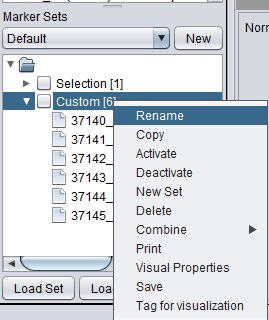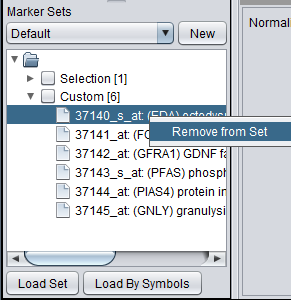Difference between revisions of "Marker Sets"
(→Overview of Marker and Array Sets) |
|||
| Line 38: | Line 38: | ||
The number of members in a set is given inside square brackets just to the right of the set name. | The number of members in a set is given inside square brackets just to the right of the set name. | ||
| − | |||
| − | + | ==Upper Pane Controls== | |
[[Image:T_Markers_Upper_RightClickMenu.png]] | [[Image:T_Markers_Upper_RightClickMenu.png]] | ||
| Line 48: | Line 47: | ||
The upper pane of the Markers component has the following controls: | The upper pane of the Markers component has the following controls: | ||
| − | + | ===Search=== | |
| − | + | Search for markers by typing in a name or portion of a name. As one types, the first marker matching the entry so far will be highlighted. In some cases however, the Find Next button must be pushed to find a match. If the typed entry matches no markers, it will be displayed in red. | |
| − | + | ===Find Next=== | |
| + | Continue search to find the next marker matching the typed entry. | ||
| + | ===Light Bulb icon=== | ||
| + | [[Image:T_Arrays_lightbulb.png]] - when activated [[Image:T_Markers_lightbulb_active.png]], enables "hover text" display of marker information including marker id, plus gene name and description if available (from annotation file). | ||
| + | |||
| + | ===Double-click action=== | ||
| + | * Double-clicking with the mouse on a marker name will add that marker to the default "Selection" set. | ||
| + | * Double-clicking on the same entry again will remove it from the "Selection" set. | ||
| + | * More generally, for any marker in the "Selection" set, double-clicking on its entry in the upper list will remove it from the set. | ||
| + | |||
| + | ===Right-click menu=== | ||
Selecting one or more markers in the list and then right-clicking gives the following choices in a pop-up menu: | Selecting one or more markers in the list and then right-clicking gives the following choices in a pop-up menu: | ||
| − | |||
| − | |||
| − | === | + | ====Add to Set==== |
| + | Selected markers can be added to a new or to an existing set. | ||
| + | |||
| + | A shortcut for adding markers to an existing set is covered in the next section. | ||
| + | |||
| + | When "Add to Set" is clicked, a dialog box will appear asking for the name of the set. Enter the name of a new or existing set. | ||
| + | |||
| + | |||
| + | ====Add to Set (Existing)==== | ||
| + | You can add markers to an existing set by either | ||
| + | * entering the name of the existing set in the popup dialog box, or | ||
| + | * before right-clicking on the selected markers, first highlight the desired marker set in the lower list. Its name will then be pre-entered into the Add to Set dialog. | ||
| + | |||
| + | |||
| + | ====Clear Selection==== | ||
| + | Clear the contents of the default "Selection" marker set. | ||
| + | |||
| + | |||
| + | |||
| + | ==Lower Pane Controls== | ||
The lower pane of the Markers component has the following controls: | The lower pane of the Markers component has the following controls: | ||
Revision as of 18:22, 17 February 2011
Contents
Overview of Marker and Array Sets
The Markers/Arrays component, located at lower left in the geWorkbench graphical interface, allows the user to define and use sets of arrays and markers for a number of purposes.
As used in geWorkbench, the term "marker" includes genes, probes/probesets, and individual sequences, depending on the type of data loaded. Sets of markers can be returned by various analysis routines. For example, the t-test returns a list of markers showing significant differential expression, and after hierarchical clustering, the markers in a subtree of the resulting dendrogram can be saved to a list.
Sets of microarrays can be used to group arrays in a meaningful fashion for statistical analysis. For example, two such phenotypes might be the diseased and normal states of a tissue from which samples have been taken. geWorkbench uses the terms "Case" and "Control" to categorize these, but in biological setting the equivalent would be "Experimental" vs "Control".
This chapter discusses the use of sets of markers. Please see the chapter Data Subsets - Arrays for a discussion of the use of Array sets.
The figure below shows the Markers component located below the Project Folders component in geWorkbench. The Arrays component is located in the same space, under the adjacent tab.
Common Principles of Operation of Marker and Array Sets
Rather than using all arrays or all markers in a data set for a particular analysis or visualization, the user may wish to restrict those used to only some subset.
Activating Sets of Markers and Arrays
In the Markers and the Arrays components, sets of markers and arrays can be defined by the user. Such sets are also created as the outcome of various analysis methods. Adjacent to each set in the graphical interface is a checkbox. Checking this box activates the subset.
- Activating a set restricts many geWorkbench components to using as input only the markers or arrays that are in one or more such activated sets.
- Marker Sets
- If no Marker set is active, all Markers are used.
- If at least one Marker set is activated, affected components will only use markers that are in activated sets.
- Array Sets
- If no Array set is active, all Arrays are used.
- If at least one Array set is activated, affected components will only use arrays that are in activated sets.
- Selection set - this is a special, default set. One is present in both the Markers component and the Arrays component. The "Selection" set has the following properties:
- Double-clicking on a marker or array entry in the upper pane list will add that entry to the default "Selection" set. Double-clicking the same entry again will remove it from the default set.
- The "Selection" set cannot be deleted.
Number of members displayed
The number of members in a set is given inside square brackets just to the right of the set name.
Upper Pane Controls
The list in upper pane of the Markers component shows the markers loaded in the current data set.
The upper pane of the Markers component has the following controls:
Search
Search for markers by typing in a name or portion of a name. As one types, the first marker matching the entry so far will be highlighted. In some cases however, the Find Next button must be pushed to find a match. If the typed entry matches no markers, it will be displayed in red.
Find Next
Continue search to find the next marker matching the typed entry.
Light Bulb icon
![]() - when activated
- when activated ![]() , enables "hover text" display of marker information including marker id, plus gene name and description if available (from annotation file).
, enables "hover text" display of marker information including marker id, plus gene name and description if available (from annotation file).
Double-click action
- Double-clicking with the mouse on a marker name will add that marker to the default "Selection" set.
- Double-clicking on the same entry again will remove it from the "Selection" set.
- More generally, for any marker in the "Selection" set, double-clicking on its entry in the upper list will remove it from the set.
Selecting one or more markers in the list and then right-clicking gives the following choices in a pop-up menu:
Add to Set
Selected markers can be added to a new or to an existing set.
A shortcut for adding markers to an existing set is covered in the next section.
When "Add to Set" is clicked, a dialog box will appear asking for the name of the set. Enter the name of a new or existing set.
Add to Set (Existing)
You can add markers to an existing set by either
- entering the name of the existing set in the popup dialog box, or
- before right-clicking on the selected markers, first highlight the desired marker set in the lower list. Its name will then be pre-entered into the Add to Set dialog.
Clear Selection
Clear the contents of the default "Selection" marker set.
Lower Pane Controls
The lower pane of the Markers component has the following controls:
- Marker Sets menu - Select which named set of markers to display. Each can contain a different arrangement of markers into subsets.
- New button - Create a new marker set.
If you right-click on a subset, a menu with the following choices appears:
- Rename - Rename the selected subset.
- Copy - Make a copy of the selected subset.
- Activate - Activate the selected subset. This can also be done directly by checking the check box before its entry.
- Deactivate - Deactivate the selected subset. This can also be done directly by unchecking the check box before its entry.
- New Set - Create a new empty marker subset.
- Delete - Delete the selected subset.
- Combine - Combine the selected subsets into a new subset. Methods are:
- Union - add all arrays from all selected sets.
- Intersection - add arrays that are in each selected set.
- XOR - add arrays that are in only one of the selected sets.
- Print - Print the selected subset of arrays.
- Visual Properties - not implemented.
- Save - not implemented.
- Tag for visualization - This feature allows a set of markers to be intersected with a network displayed in the Cytoscape component. Any markers that are in the "tagged" set and which also appear in the Cytoscape display will be highlighted yellow.
Examples
Add a marker to the default set by double-clicking
Double-clicking a marker in the upper list adds it to the default "Selection" subset.
Adding markers to a new or existing subset
If one or more markers are selected in the upper list, and then right-clicked on, a menu will appear with option "Add to Set".
Choosing "Add to Set" will bring up a dialog box in which the name of a new or existing subset can be input. Here we type the name of a new marker subset "Custom" into the dialog box.
The markers are copied to the new subset with name "Custom":
Adding markers to an existing subset - shortcut
If you wish to add additional markers to an existing subset, you can avoid having to type in its name again in the dialog box by first selecting the target subset in the lower pane. Then right-click on a selection of markers above. The name of the existing subset will appear in the "Add to Set" dialog.
Manipulating marker subsets
Right-clicking on a subset brings up a menu with options described above in the lower-pane controls section.
Individual markers can also be selected and removed from a subset by a right-click menu.
Create a new set
The New button creates a new set (group), which in turn can be used to contain a different arrangement of subsets.
Here the Set pulldown menu shows the newly created new Set.












